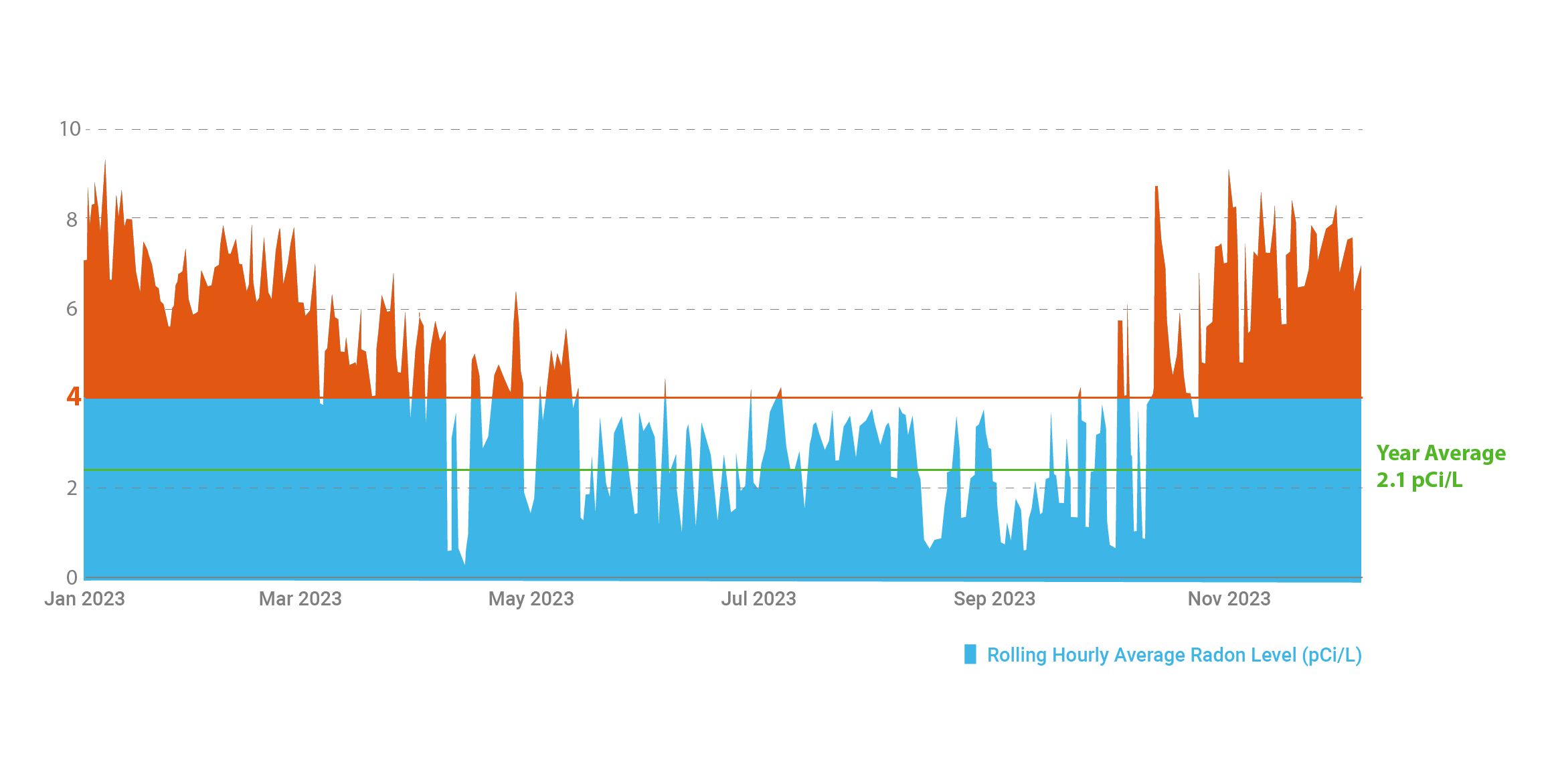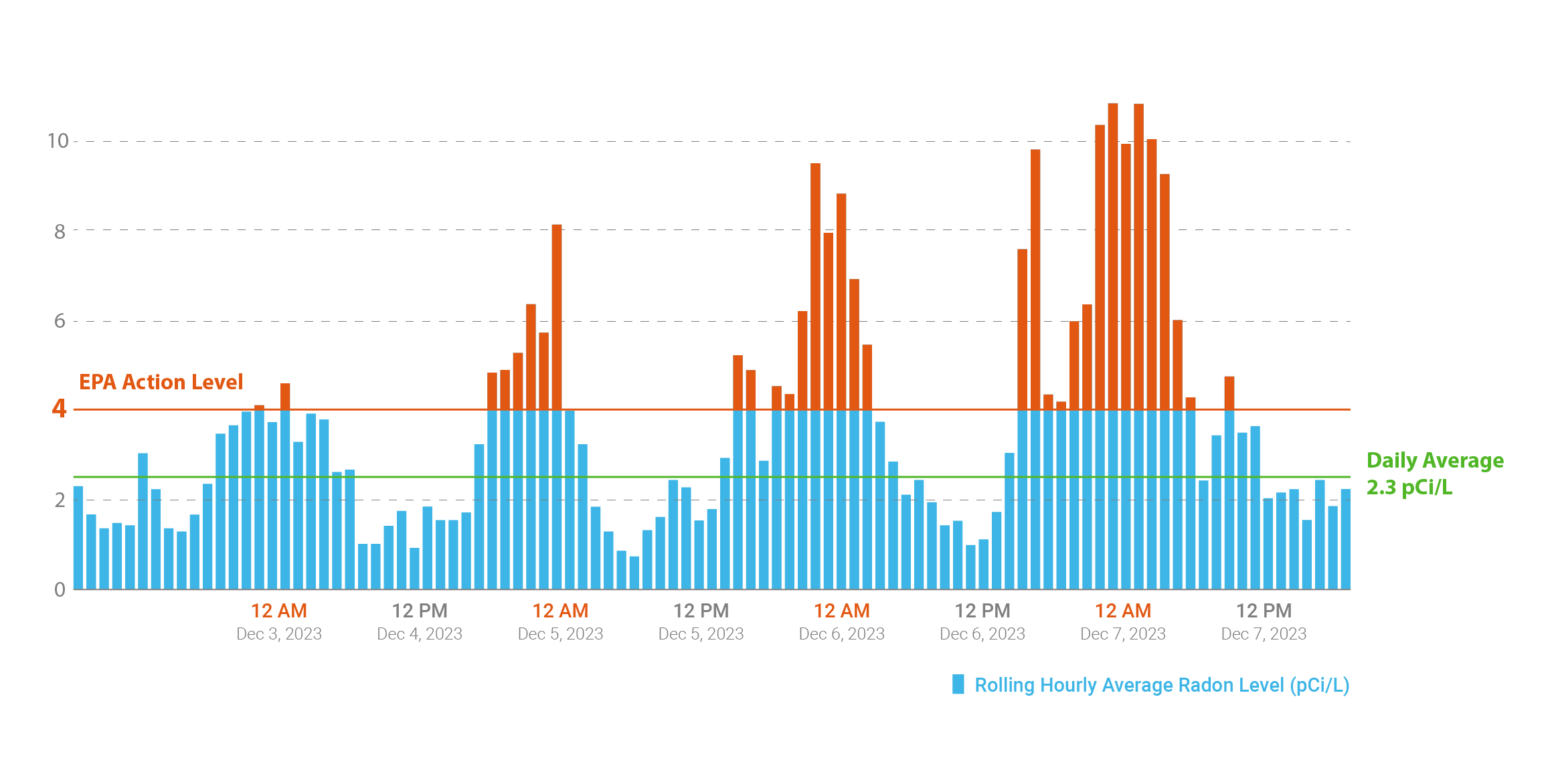Why Do Radon Levels Fluctuate

Radon testing is the only way to know the level of exposure to cancer-causing radon gas. Radon is a naturally occurring gas with no color, taste, or odor that silently seeps into our homes, earning it the nickname 'Silent Killer'. It’s the leading cause of lung cancer among those who do not smoke, accounting for 16.5% of all lung cancer deaths in the United States. Recognizing that radon levels fluctuate, often overlooked, is crucial because prolonged exposure to high levels of radon significantly increases the risk of lung cancer.
By continuously monitoring how radon levels fluctuate we can proactively prevent lung cancer risk associated with radon exposure. Through accurate radon testing, timely action, and effective mitigation measures, homeowners can safeguard not only their well-being but also that of their loved ones.
In this blog, we’ll explain why radon levels fluctuate, their implications for homeowners, and effective radon testing and mitigation strategies.
Below are the reasons why radon levels fluctuate:
- Temperature differences: indoors vs. outdoors
- Home sealing and insulation levels
- Insufficient home ventilation system
- Increased heating in colder seasons
- Weather conditions like snow, ice, or rain
- Decreased airflow during inactivity or sleep
- Home occupancy patterns
- Variations in atmospheric pressure
Radon Levels Fluctuate from Season to Season
Many homeowners begin to monitor their radon levels during the spring or summer, shortly after moving into a new home. The weather is nice, and there's little temperature difference between indoors and outdoors. During warmer months, homes are well-ventilated with open windows and doors, typically yielding lower measurements in radon testing results.
However, as temperatures drop and we seal our homes tightly against the cold, we see a different radon trend. The temperature between indoors and outdoors is now different. With reduced ventilation and continued heating, radon becomes trapped indoors. This is how.
You may notice that when heating your home, the upper floors are often warmer than the lower ones. This happens because warm air naturally rises and escapes through the roof, creating a vacuum-like airflow. This airflow accelerates the radon gas entry from the soil into the house. The gas moves upwards along with the warm air, entering the house through cracks in the foundation, gathering at the ground level, and gradually diluting as it ascends to the upper floors.
Keep in mind that airtight and energy-efficient homes are designed to minimize the exchange of air between the inside and outside environments. While this is beneficial for reducing energy consumption and maintaining comfortable indoor temperatures, if planned energy-efficient ventilation isn’t added, it can trap indoor air pollutants, including radon gas.
Moreover, snow and ice around the house can worsen this process, making it easier for radon gas to get in. This effect is the strongest during the colder months when the temperature difference between indoors and outdoors is at its peak, leading to higher radon levels (see the graph below).
Ignoring seasonal radon changes raises the risk of prolonged exposure to high levels significantly increasing the risk of lung cancer.

Radon Seasonal Variations: EcoQube Data Analysis, January - December 2023, Colorado.
Radon Levels Fluctuate Every Day
Besides seasonal variations, radon levels often rise naturally during nighttime. It's common to observe radon levels increasing, particularly in the hours before sunrise. This phenomenon happens, again, due to the peak temperature difference between indoor and outdoor environments, often resulting in elevated indoor radon levels during the night.
Additionally, occupancy patterns can affect radon levels daily. Reduced airflow during periods of absence, such as office hours or sleep, may lead to the buildup of radon gas. When normal activity resumes, increased airflow facilitates the dispersal of radon, thereby lowering its concentration levels.
Radon levels also fluctuate on rainy days rising due to changes in atmospheric pressure and soil moisture. When it rains, water fills up tiny spaces in the soil where radon gas is found, forcing it to move more freely and increasing its concentration. Rainy conditions often coincide with low-pressure systems, such as "cloudy days," which further facilitate the movement of radon gas from the soil into buildings.
Radon testing should not be approached as a one-time measurement matter. It's not a "test it and forget it" situation - it demands continuous attention and management.

Radon Daily Variations: EcoQube Data Analysis, December 3-7, 2023, Colorado.
Tips for addressing radon fluctuations
Tip 1: Choose the right radon testing device
Radon testing with advanced radon detectors such as EcoBlu, EcoQube or RadonEye offers insights into both daily radon fluctuations and seasonal changes. These state-of-the-art monitors offer precise updates on radon concentrations every 10 minutes, ensuring sensitivity to even the most subtle shifts in radon levels.
Recognizing that radon levels fluctuate all the time, relying solely on a one-time radon test, such as a traditional charcoal test kit with a single measurement result, can be misleading as it fails to capture fluctuations that occur, for instance, during nighttime or rainy days.
Essentially, real-time measurements play a crucial role in establishing a Rolling Hourly Average, preventing any “smoothing over” or overlooking radon fluctuations. This distinctive blend of fast response and ultra-sensitivity, characteristic of digital radon detectors, ensures the most reliable evaluation of both short-term radon levels and long-term trends.
Tip 2: Increase ventilation
When you see your radon levels go up, increasing ventilation can help mitigate your exposure to this harmful gas. During warmer months, one effective DIY strategy to lower indoor radon levels is to open windows to facilitate fresh air circulation. However, during colder months, no one wants to let the cold air come in. Instead, configuring your HVAC system for planned mechanical ventilation can serve as a viable short-term mitigation tactic. It's crucial to be cautious during colder months, as opening upper-floor windows while keeping lower-level windows closed may worsen the radon situation. This action can draw more air upward from the ground surrounding the house, potentially leading to elevated radon levels within your home.
Tip 3: Contact radon professional
Even if your average radon level remains below the action threshold, frequent daily fluctuations may still occur. In such cases, seeking professional assistance becomes essential to effectively mitigate these short-term spikes. Similarly, if you notice consistent radon fluctuations, particularly during colder weather, consulting a professional is advisable to implement effective long-term mitigation strategies.
Radon levels fluctuate in response to various environmental and structural factors. Recognizing these fluctuations and their implications is crucial for maintaining a healthy indoor environment. Digital radon detectors allow you to take proactive and effective radon management actions and protect your well-being. Stay informed, stay vigilant, and take action to safeguard your home from this silent threat.

Great post! Radon levels can fluctuate due to changes in weather, ventilation, and even the season. Factors like temperature, pressure differences, and how often windows are opened all affect how much radon enters your home. Understanding this helps ensure accurate testing and better safety measures. Thanks for explaining!
Great question! Radon levels fluctuate due to factors like weather, temperature, and air pressure. For example, high winds, rainfall, or changes in barometric pressure can affect radon entry into a home. Regular testing is key to keeping track of these fluctuations and ensuring safety.
Radon levels fluctuate due to factors like weather, ventilation, and air pressure. Cold weather, for example, can trap radon indoors, while wind and rain affect how it moves through the soil. Regular testing helps track these changes for accurate results.
My radon detector was reading 2.1 for a week, now it’s reading 4.1 for 3 days, is this normal?
Great blog! Radon levels fluctuate due to weather, seasons, and home ventilation changes. It’s important to monitor regularly to stay safe.